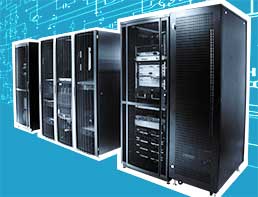The Raritan Blog
Home » Raritan Blog » Data Center Operations Best Practices
Data Center Operations Best Practices
Paula Alves
February 10, 2014
 Data Center operations best practices call for a strategic approach to balancing IT service delivery and cost efficiency. With the growing complexity of data centers from the demand for new service offerings and the sheer amount of physical compute, network, and storage required to provide those services, Data Center Managers are quickly realizing that manual tools, such as excel spreadsheets and Visio diagrams, are no longer an effective way to manage their Data Centers. Instead, sophisticated data center infrastructure management (DCIM) tools that measure, monitor, and provide a best practices operations framework are needed.
Data Center operations best practices call for a strategic approach to balancing IT service delivery and cost efficiency. With the growing complexity of data centers from the demand for new service offerings and the sheer amount of physical compute, network, and storage required to provide those services, Data Center Managers are quickly realizing that manual tools, such as excel spreadsheets and Visio diagrams, are no longer an effective way to manage their Data Centers. Instead, sophisticated data center infrastructure management (DCIM) tools that measure, monitor, and provide a best practices operations framework are needed.
According to a 2012 IDC report “Most are pursuing a path to ensure appropriate levels of IT service delivery and cost efficiency and alignment to business goals. For some data centers, this means providing state of the art levels of availability, flexibility, and scalability, while for others the goal may be to provide “sufficient” levels of services while keeping new capital expenditures to a minimum.“ In fact, IDC also quantified that “Data centers that are operating at the highest level of efficiency allocate 50 percent more of their IT resources to new projects.”
To become more efficient and to ensure that the demand for new services can be met by the capacity and the infrastructure, successful IT organizations have spent a lot of time creating a set of best practices surrounding an organization’s tools, technologies and processes. It’s about using these tools to provide a more functional, reliable, and energy-efficient data center. Here are some of the best practices, centered around the use of DCIM tools, organizations like yourself have adopted:
Know what you have – identify your current assets, their connections, and capacity information storing all such information in a single database repository system. Having all this information in a single place ensures accurate capacity planning and forecasting, faster provisioning, quicker troubleshooting and mean time to repair (MTTR).
Benchmark your current performance – you can’t measure what you don’t monitor. Use meters and monitoring tools to identify current energy performance, hot spots, heat-related equipment failure. Using this data later to compare trends data over time to baseline performance can help predict and avoid equipment failure, improving long-term reliability
Optimize to maximize capacity and utilization. Develop an Energy Management Program to minimize ongoing energy costs. Continually measure and adjust energy usage, Power Usage Effectiveness (PUE), airflow, cooling, humidity, temperature, and power. Use this data to understand what draws energy in your facility, do more with less, find ways to save on energy usage, and adjust to real-time operating conditions, including lowering/raising temperature set points to maintain a safe environment for your IT equipment.
Plan and change management throughout the entire lifecycle. Put processes in place to enable quick response, streamlining of activities, and the ability to audit. Automate as many of the manually intensive processes to reduce errors and time to deploy.
Review and analyze space, power, and energy performance to maintain an optimized data center. Use dashboard, performance, and trending reports to predict future needs.
Ensure IT and facilities management work together to understand the business objectives, develop plans for integrating services and infrastructure, as well as to share the cost burden.
What are the best practices that you follow today in managing your data center? Share your ideas here or download our eBook “Why use DCIM in a Data Center Refresh (Interview with City of Boston)” and read more about how successful companies have implemented DCIM tools as part of their best practices.
Other Blog Posts
- The Rapid Growth of AI and the Use of Raritan PDUs to Meet Higher Power Demands
- Posted on October 11, 2023
- Data Center Report Fewer Outages, But Downtime Still Costly
- Posted on September 20, 2023
- Survey: Energy Usage and Staffing Shortages Challenge Data Centers
- Posted on September 20, 2023
- Raritan Secure Switch: Secure NIAP 4.0 Compliant Desktop KVM
- Posted on September 20, 2023
- The Midwest is a Hot Market for Data Centers: How the New Generation of Intelligent Rack PDUs Can Save Cloud Giants Uptime and Money
- Posted on September 7, 2023
Subscribe
Upcoming Events
- AFCOM Data Center World
- April 15 – 18 • Walter E Washington Convention Center - Washington, DC
- Advancing Data Center Construction West 2024
- May 6 – 8 • Salt Lake City, UT
- Net Zero Data Center
- May 16 – 17 • Dallas, TX
- 7x24 Exchange Spring
- June 9th • JW Marriott Orlando Grande Lakes
Latest Raritan News
- Legrand Certifications and Process Controls Provide Confidence in Information Security for Network-Connected Devices in Data-Related Applications
- Posted on April 1, 2024
- Legrand Releases Version 4.0 of Raritan’s Industry-Leading Secure KVM Switches, Raising Bar for Secure Desktop Access
- Posted on July 31, 2023
- Legrand Revitalizes Data Center Sector with Two Revolutionary Intelligent Rack PDUs
- Posted on May 1, 2023
- Raritan Reveals The MasterConsole® Digital Dual KVM Switch
- Posted on February 18, 2021
- Legrand Data, Power and Control Division Announced as Finalist in Six Categories at DCS Awards 2020
- Posted on November 9, 2020